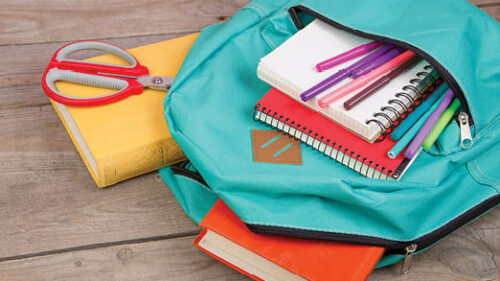In the days ahead, millions of students will be heading back to the classroom for the start of another school year. Many will pose for the customary front porch photo and then head off to the bus with a backpack filled with items they’ll use over the course of the next nine months. Pens, paper, and an art smock, just to name a few.
Which got me thinking: are there supplies from a student’s backpack that are also critical to success in safety and risk management?
Risk & Safety Professional’s Supply List
So, I grabbed my elementary student’s backpack and looked inside. After a few minutes, I had sketched out the “Risk & Safety Professional’s Supply List.” Below is what it contains.
Highlighters and Indicators
Being a safety professional can be a tough job, especially if lagging indicators like injury rates aren’t where you want them to be. Use highlighters to draw attention to your successes, such as the development of leading indicators that will improve future results. After every success, understand what factors led to the desirable result so you can highlight even more wins in the future.
Scissors (blunt tip) and Change
OK, so maybe you’ll never use a pair of blunt-tip scissors. But hang them near your desk as a reminder that the best changes are often the ones that design out the risk upstream, instead of using solutions like training workers on hazard avoidance or providing personal protective equipment. Where else in your business can you make a simple change that makes the work a lot safer?
Erasers and New Practices
Let’s face it, we’re all going to make mistakes. But these erasers aren’t for removing the evidence of past decisions. Rather, they are your permission slip that it’s OK to change your mind when you learn something new. Maybe you attended a webinar on a new topic or had lunch with someone who’s successful in a similar role at another company. Keep a log of your best risk management practices, but don’t be afraid to erase them when an even better practice comes along.
Ruler and Key Metrics
Some days you might wonder if you’re making any progress. You are — an inch at a time. Be sure your measurement system accounts for all the things that matter in your business. For example: If your “safety” fix improved quality, productivity, morale, or some other key metric, move four inches forward instead of just one!
Glue Sticks and Communication
As my colleague Larry Poague wrote about in a recent blog, safety is the bridge to communication within a company. People expect to talk about safety at work, and it can be the glue that brings a company together and allows it to achieve new heights.
Sketch Pad (no lines)
Some of the best ideas for managing risk come when good safety professionals think “outside the lines.” Give yourself the freedom to dream bigger, to start with a blank sheet of paper, and imagine what could be. Grab your highlighters and create an idea for every color. Erase them (OK, maybe just grab a new sheet) if your first ideas might not work. Ask yourself, “how can I blunt-tip this issue upstream so I’m not dealing with an injury later on?”
Doing the Simple Things in Risk and Safety Well
As you can see, a lot of the supplies we need to be successful in safety and risk management are those we’ve been using since elementary school, which should come as no surprise. Success in risk and safety usually involves doing a lot of simple things repeatedly well. When we can stack those simple things together and glue them into place, we’re on the path toward a good-looking report card.
If you have questions about how we can help you create a better risk and safety program in your organization, please don’t hesitate to reach out to us. We’re happy to help!







